| dc.contributor.author | Malik, Rainer | |
| dc.contributor.author | Georgakis, Marios K. | |
| dc.contributor.author | Vujkovic, Marijana | |
| dc.contributor.author | Damrauer, Scott M. | |
| dc.contributor.author | Elliott, Paul | |
| dc.contributor.author | Karhunen, Ville | |
| dc.contributor.author | Giontella, Alice | |
| dc.contributor.author | Fava, Cristiano | |
| dc.contributor.author | Hellwege, Jacklyn N. | |
| dc.contributor.author | Shuey, Megan M. | |
| dc.contributor.author | Edwards, Todd L. | |
| dc.contributor.author | Rogne, Tormod | |
| dc.contributor.author | Åsvold, Bjørn Olav | |
| dc.contributor.author | Brumpton, Ben Michael | |
| dc.contributor.author | Burgess, Stephen | |
| dc.contributor.author | Dichgans, Martin | |
| dc.contributor.author | Gill, Dipender | |
| dc.date.accessioned | 2022-03-04T12:04:23Z | |
| dc.date.available | 2022-03-04T12:04:23Z | |
| dc.date.created | 2021-12-20T09:35:54Z | |
| dc.date.issued | 2021 | |
| dc.identifier.citation | Hypertension. 2021, 2004-2013. | en_US |
| dc.identifier.issn | 0194-911X | |
| dc.identifier.uri | https://hdl.handle.net/11250/2983140 | |
| dc.description.abstract | Observational studies exploring whether there is a nonlinear effect of blood pressure on cardiovascular disease (CVD) risk are hindered by confounding. This limitation can be overcome by leveraging randomly allocated genetic variants in nonlinear Mendelian randomization analyses. Based on their association with blood pressure traits in a genome-wide association study of 299 024 European ancestry individuals, we selected 253 genetic variants to proxy the effect of modifying systolic and diastolic blood pressure. Considering the outcomes of incident coronary artery disease, stroke and the combined outcome of CVD, linear and nonlinear Mendelian randomization analyses were performed on 255 714 European ancestry participants without a history of CVD or antihypertensive medication use. There was no evidence favoring nonlinear relationships of genetically proxied systolic and diastolic blood pressure with the cardiovascular outcomes over linear relationships. For every 10-mm Hg increase in genetically proxied systolic blood pressure, risk of incident CVD increased by 49% (hazard ratio, 1.49 [95% CI, 1.38–1.61]), with similar estimates obtained for coronary artery disease (hazard ratio, 1.50 [95% CI, 1.38–1.63]) and stroke (hazard ratio, 1.44 [95% CI, 1.22–1.70]). Genetically proxied blood pressure had a similar relationship with CVD in men and women. These findings provide evidence to support that even for individuals who do not have elevated blood pressure, public health interventions achieving persistent blood pressure reduction will be of considerable benefit in the primary prevention of CVD. | en_US |
| dc.language.iso | eng | en_US |
| dc.publisher | American Heart Association | en_US |
| dc.rights | Navngivelse 4.0 Internasjonal | * |
| dc.rights.uri | http://creativecommons.org/licenses/by/4.0/deed.no | * |
| dc.title | Relationship between Blood Pressure and Incident Cardiovascular Disease: Linear and Nonlinear Mendelian Randomization Analyses | en_US |
| dc.type | Peer reviewed | en_US |
| dc.type | Journal article | en_US |
| dc.description.version | publishedVersion | en_US |
| dc.source.pagenumber | 2004-2013 | en_US |
| dc.source.journal | Hypertension | en_US |
| dc.identifier.doi | 10.1161/HYPERTENSIONAHA.120.16534 | |
| dc.identifier.cristin | 1970370 | |
| cristin.ispublished | true | |
| cristin.fulltext | original | |
| cristin.qualitycode | 2 | |

